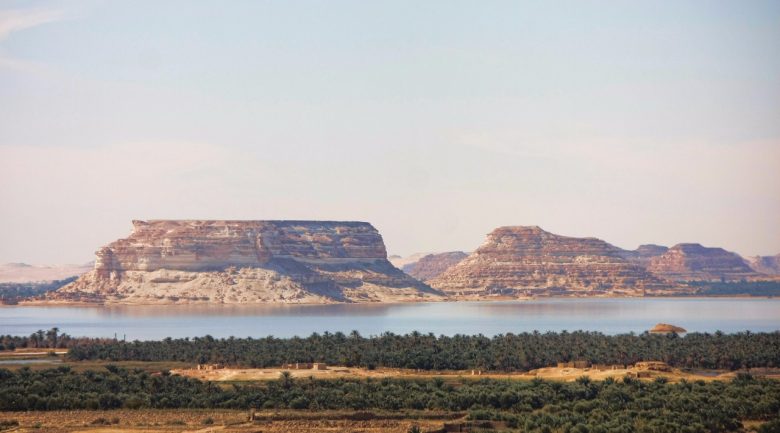By Muhammed Aladdin
A desert is an unforgiving environment, with scorching heat, relentless sandstorms, and inexplicable vastness. Egypt has two of these deserts on both sides of the River Nile, however, to the west, amidst the bleakness, life found its way.
Within the Western Desert, in defiance to all expectations, underground water reservoirs exploded to the surface forming five of the most picturesque oases in the world. These watering holes allowed palms and shrubs to grow, attracting the many animals, and finally, humans that came to inhabit them.
Today, these five oases are an Egyptian national treasure, and some of the many, unknown places in Egypt that are truly worth a visit.
Here is our guide to the Oases of the Western Egyptian Desert!
El Dakhla Oasis

Situated between El Kharga and Farafra Oases, El Dakhla is perhaps the most beautiful of all five western watering holes. It is a lush green land with magenta cliffs and poetic verdant gardens surrounded by an unforgiving desert; a rose growing from concrete, one might say.
Once in the Badawiya Dakhla Hotel pool, the scenery of the oasis presents itself with inexplicable majesty that overwhelms the heart.
Scientists believe that thousands of years ago, “The Inner Oasis”, better known as El Dakhla, used to be a great lake that was home to many animals including elephants and bison.
El Kharga Oasis

In the time of ancient Egypt, El Kharga Oasis, or “The Outer Oasis” in English, was known to the Pharaohs as the Oasis of Thebes, due to its close proximity to the city of Luxor. The oasis is surrounded by a ring of mountains, shifting dunes, and beautiful scenery. In some regions, fossils of dinosaurs that roamed Egypt hundreds of millions of years ago can be found.
With calming waters amidst healing sand, El Kharga Oasis is the largest in the Western Desert of Egypt. It is home to the ancient Egyptian Temple of Hibis, one of the best-preserved religious centers of the Saite-Persian period of the country’s history.
Farafra Oasis

Near the western Egyptian borders lies a piece of heaven on earth; a sanctuary far from the hustle and bustle of the busy cities. Farafra Oasis is one of the most secluded places in all of Egypt with clean air, captivating scenes, and plenty of cultures.
The pristine oasis is the second largest in the Western Desert, located on the borders of what is called the White Desert, a picturesque landscape of wind-carved chalk formations. There, a long, uninterrupted dive into the hot springs of Bir Sitta would melt all the stress and detoxify the soul.
El-Mufid Lake in Farafra is one of the most beautiful water bodies in all of Egypt, a nice place to share the sunset with a loved one. On the other hand, the Crystal Mountain complete with stalactites and stalagmites formations is not to be missed.
Some parts of the town are built in the ancient Bedouin architecture with simple, smooth mud-based homes.
El Bahariya Oasis

Located at the northernmost part of the Western Desert, El Bahariya Oasis is a speck of green palm trees and blue azure waters surrounded by an ocean of yellow sand dunes. Its waters nourish the lives of its inhabitants from birds to humans.
The oasis is well-known for its hot springs and good hiking routes, but people from all over the world come here to go on the Golden Mummies tour or perhaps visit the Black Mountain, an ancient basaltic flow teeming with volcanic glassy stones.
Many tourists come for the ancient Egyptian heritage with ruins from the Middle Kingdom’s wineries and trading posts and two museums located in Bawati town. Also, the Temple of Alexander, built by Alexander the Great on his way to Siwa, is one history-rich place to visit.
Siwa Oasis

South of Marsa Matruh, between the Great Sand Sea and the Qattara Depression, lies one of the most beautiful of Egypt’s destinations, Siwa. It is indeed one of the most secluded places in the country, yet it is filled to the brim with the distinct Berber culture.
About 33,000 Egyptian Berbers inhabit the oasis, with their own unique culture and language. The people there are more than happy to speak in lengths about the date agriculture and the family structure of a Siwan home. Indeed, their generous, simple lives are warm and inviting.
Siwa Oasis is well-known for its limestone cliffs and mud-built ruins of the castle that was once called Shali. A few miles from the ancient fort lies the remainings of the Temple of Ammon, where the oracle crowned Alexander as King of Egypt and Son of Ammun.
The beautiful city has a market that has many handmade wonders, as well as the world-renowned Siwan dates and olives.



